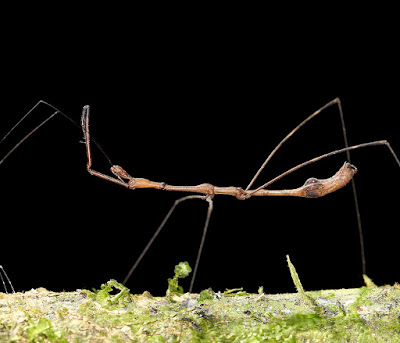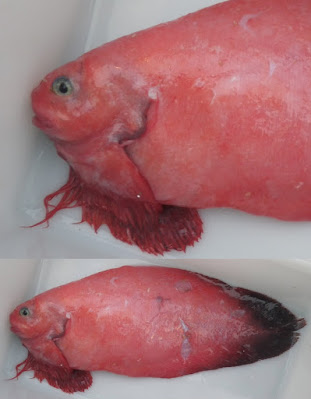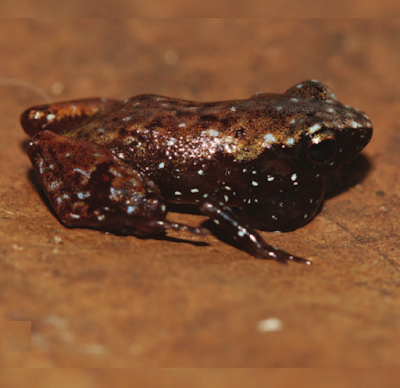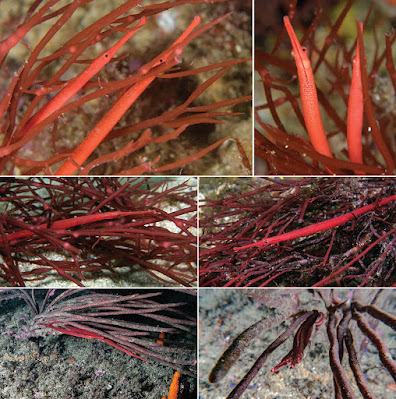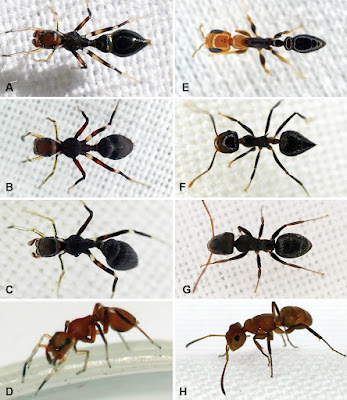[Most Recent Entries] [Calendar View]
Sunday, November 22nd, 2020
| Time | Event | ||||||||||
| 9:25a | [Entomology • 2020] Delicate and Diverse: A Taxonomic Monograph with A Phylogenetic Analysis of the Neotropical Genus Ghilianella Spinola (Hemiptera: Reduviidae: Emesinae)
Abstract The Neotropical thread-legged bug genus Ghilianella Spinola, 1850 is the most diversified within Metapterini. A taxonomic revision of Ghilianella is presented, in which seventy seven species are recognized as valid, with twenty-one described as new: Ghilianella berengeri sp. nov.; Ghilianella bifurcata sp. nov.; Ghilianella bolivari sp. nov.; Ghilianella caldensis sp. nov.; Ghilianella dilatata sp. nov.; Ghilianella embera sp. nov.; Ghilianella fernandezi sp. nov.; Ghilianella ferruginosa sp. nov.; Ghilianella gilsantanai sp. nov.; Ghilianella goliath sp. nov.; Ghilianella gracilis sp. nov.; Ghilianella huaorani sp. nov.; Ghilianella jaguar sp. nov.; Ghilianella laticauda sp. nov.; Ghilianella maricruzae sp. nov.; Ghilianella quimbaya sp. nov.; Ghilianella scimitarra sp. nov.; Ghilianella tica sp. nov.; Ghilianella urbanoi sp. nov.; Ghilianella ventrimaculata sp. nov.; and Ghilianella weirauchae sp. nov. For the first time a female specimen is described for Ghilianella atriclava Bergroth, 1911, Ghilianella colona McAtee & Malloch, 1925 and Ghilianella pachitea McAtee & Malloch, 1925. Three new synonyms are recognized: Ghilianella bulbifera Champion, 1898 (=Ghilianella pendula McAtee & Malloch, 1925 syn. nov.; Ghilianella inflata Maldonado, 1981 syn. nov.) and Ghilianella strigata McAtee & Malloch, 1925 (=Ghilianella fenestrata Maldonado, 1960 syn. nov.). Eleven species are considered nomina dubia and one species nomen nudum. A key to species and digital images of the external morphology and genitalic structures for each species are provided. Additionally, we offer the first phylogenetic hypothesis of relationships within Ghilianella, using cladistic methods. Based on the phylogenetic results we dismiss all subgenera in Ghilianella and discuss the complex evolution of the abdominal expansions. Keywords: Taxonomic revision, phylogeny, Ghilianella, Ghinallelia, Metapterini, Neotropical region Ghilianella strigata McAtee & Malloch, 1925 Valentina Castro-Huertas, Dimitri Forero and Jocelia Grazia. 2020. Delicate and Diverse: A Taxonomic Monograph with A Phylogenetic Analysis of the Neotropical Genus Ghilianella Spinola (Hemiptera: Reduviidae: Emesinae). Zootaxa. 4879(1); 1-194. DOI: 10.11646/zootaxa.4879.1.1 | ||||||||||
| 9:45a | [Ichthyology • 2020] Careproctus ambustus • A New Species of Snailfish (Cottiformes: Liparidae) Closely Related to Careproctus melanurus of the Eastern North Pacific
Abstract A new species, Careproctus ambustus, is described from 64 specimens based on evidence from morphological and molecular data. Specimens of Careproctus ambustus, new species, have been historically misidentified as the common Blacktail Snailfish, C. melanurus. The new species is distinguished from C. melanurus by its higher numbers of vertebrae (62–66 vs. 56–62 in C. melanurus), dorsal-fin rays (57–63 vs. 53–58), and anal-fin rays (51–55 vs. 46–51), and longer pelvic disc (14.1–21.2 vs. 12.6–20.7 % HL). In addition, the new species differs from C. melanurus by seven base pairs within a 492-base-pair region of the cytochrome oxidase c subunit 1 region, a 1.4% sequence divergence. Careproctus ambustus, new species, is found at depths of 58–1,172 m and ranges from Japan, through Alaska, to the west coast of Vancouver Island, British Columbia, where its distribution overlaps with C. melanurus, which ranges from southern Alaska and British Columbia to Baja California. Careproctus (Allochir) ambustus, new species, Orr Scorched Snailfish Diagnosis.— Careproctus ambustus is distinguished from all other North Pacific species of Careproctus except C. melanurus by the combination of the shape of its pelvic disc, which is oval, longer than wide (vs. round or wider than long in other species of Careproctus), shallowly cupped (vs. flat or deeply cupped), and somewhat smaller than the orbit (vs. minute or large); shallowly notched pectoral fin with elongate rays in the lower lobe (vs. deeply notched with elongate or short rays, or shallowly notched with short rays in other species of Careproctus); and unique COI haplotypes (Orr et al., 2019). It is further distinguished morphologically from C. melanurus, with which it has been historically confused, by its higher vertebral and median fin-ray counts (vertebrae 61–67 vs. 56–62, dorsal-fin rays 57–63 vs. 53–59, anal-fin rays 51–57 vs. 46–52 in C. melanurus), in combination with its longer pelvic disc (14.1–21.2 vs. 12.6–20.7 % HL in C. melanurus). ... Distribution.—Careproctus ambustus is known in the North Pacific Ocean from British Columbia, Alaska, Russia, and Japan (Fig. 3) at depths of 58 to 1,172 m, based on material examined and confirmed field identifications (Tokranov, 2000; Orr et al., 2014a, 2014b; G. R. Hoff, pers. comm., 2016). In the eastern North Pacific, it ranges from British Columbia off central Vancouver Island, throughout the Gulf of Alaska and Aleutian Islands, and into the eastern Bering Sea to at least 60.3°N (Hoff, 2016) and off Cape Navarin in the western Bering Sea (Parin et al., 2014). In the western North Pacific, it ranges from Kamchatka and the Kuril Islands, Russia (Orlov, 1998, 1999, 2001; Sheiko and Fedorov, 2000; Orlov and Tokranov, 2011), to the northwestern coast of Honshu, Japan (Kido and Shinohara, 1997). Etymology.—The specific epithet of Careproctus ambustus is taken from the Latin ambusti, meaning “scorched,” referring to the black tail that contrasts with the pink to red anterior part of the body. James W. Orr, Dmitry L. Pitruk, Rachel Manning, Duane E. Stevenson, Jennifer R. Gardner and Ingrid Spies. 2020. A New Species of Snailfish (Cottiformes: Liparidae) Closely Related to Careproctus melanurus of the Eastern North Pacific. Copeia. 108(4); 711-726. DOI: 10.1643/CI2020008 | ||||||||||
| 10:03a | [Herpetology • 2020] Adelophryne amapaensis • A New Amazonian Species of the Diminutive Frog Genus Adelophryne (Anura: Brachycephaloidea: Eleutherodactylidae) from the State of Amapá, Northern Brazil
Abstract During recent field expeditions to an Amazonian region in eastern Guiana Shield (Serra do Navio, state of Amapá, northern Brazil), we collected and recorded calls of a species of Adelophryne, a diminutive leaf-litter-dwelling, direct-developing frog genus. After a careful integrative taxonomic evaluation using morphological, molecular, and bioacoustic data, we concluded that the series of specimens collected represent a new taxon, which we describe herein. The new species of Adelophryne is distinguished from all ten congeners by the following combination of character states: (1) male SVL = 12.5 mm; female SVL = 13.0–14.4 mm; (2) tympanic membrane present; (3) tympanic annulus present, incomplete; (4) vomerine teeth absent; (5) finger terminal discs absent; (6) tips of Fingers I–IV mucronate; (7) finger pads present (formula 1–1–2–1); (8) three phalanges in Finger IV; (9) dorsum smooth; (10) cloacal flap absent; (11) multi-note advertisement call composed of non-pulsed notes; (12) the call dominant frequency (4,802–5,706 Hz) coincides with the fundamental harmonic. Our study describes the eleventh species of Adelophryne, and, despite the increase in taxonomic knowledge within the past few years, there are still some species in the genus lacking a formal taxonomic description.
Adelophryne amapaensis, new species Etymology.—The species is named after the Brazilian state of Amapá, from which all known specimens come. The specific epithet is used here as a noun in apposition.
Pedro P. G. Taucce, Carlos E. Costa-Campos, Célio F. B. Haddad and Thiago R. de Carvalho. 2020. A New Amazonian Species of the Diminutive Frog Genus Adelophryne (Anura: Brachycephaloidea: Eleutherodactylidae) from the State of Amapá, Northern Brazil. Copeia. 108(4); 746-757. DOI: 10.1643/CH-19-254 | ||||||||||
| 3:00p | [Ichthyology • 2020] Stigmatopora harastii • A New Species of Pipefish (Syngnathiformes, Syngnathidae) in Facultative Associations with Finger Sponges and Red Algae from New South Wales, Australia
Abstract A new species of pipefish, Stigmatopora harastii sp. nov., is described based on the male holotype and two female paratypes, 136.3–145.5 mm SL, collected from red algae (sp.?) at 12 meters depth in Botany Bay, New South Wales (NSW), Australia. The new taxon shares morphological synapomorphies with the previously described members of Stigmatopora, including principle body ridges, fin placement, slender tail, and absence of a caudal fin. It is morphologically and meristically similar to Stigmatopora nigra, including snout length and shape, dorsal-fin origin on 6th–7th trunk ring, and lateral trunk ridge terminating on the first tail ring. Stigmatopora harastii sp. nov. is distinguished from its congeners, however, by characters of the head and first trunk ring, distinct sexual dimorphic markings on sides and venter of anterior trunk rings, and red background coloration in life. The new taxon can be further differentiated by genetic divergence in the mitochondrial COI gene (uncorrected p-distances of 9.8%, 10.1%, 10.7%, and 14.6%, from S. argus, S. macropterygia, S. narinosa, and S. nigra, respectively). The type locality is characterised by semi-exposed deep-water sandy areas interspersed with boulders, flat reefs, and an absence of seagrass beds, in which S. harastii has been observed living in facultative associations with a finger sponge and red algae at depths of 10–25 meters, compared to the shallow coastal and estuarine habitats preferred by the fucoid algae and seagrass-associating members of Stigmatopora. Stigmatopora harastii sp. nov. represents the fourth species of Stigmatopora recorded in temperate southern Australia. Keywords: Botany Bay, COI, cryptobenthic, ichthyology, Jervis Bay, marine fish, morphology, South Pacific, Sydney, systematics, taxonomy
Stigmatopora harastii sp. nov. Diagnosis: Stigmatopora harastii differs from its congeners by the following combination of morphological characters: median ridge, distinct, low, present on dorsum of head and first trunk ring starting from the posterior third of the frontal, over the supraoccipital, to the anterior and posterior nuchal plates; opercular ridge prominent, complete, not angled dorsad; lateromedial ridge, distinct, low, present between opercle and pectoral fin base; dorsal-fin origin on 6th–7th trunk rings, subdorsal rings 19–20 (12 trunk rings + 7 or 8 tail rings); lateral trunk ridge ends on first tail ring. Colouration: red background colour; dorsum of snout with large, irregular pale white spots; sides of head and anterior trunk rings with large, irregular pale white spots or with diffuse pale white stripe; venter of first trunk ring with distinct red elongated spots in longitudinal row, almost forming a stripe, on midline present in male (AMS I. 49510-001); venter of anterior trunk rings pale red with a large cluster of distinct red spots extending posteriad from second trunk ring in male (AMS I. 49510-001), few scattered small red spots in females (AMS I.1.47267). Etymology: This species is named after David Harasti, one of the first to recognize S. harastii as being a new species, for recognition of his efforts towards conservation of Syngnathidae in Australia, and for being an aficionado extraordinaire of his beloved genus Stigmatopora. David has stated he counts green pipefish to fall asleep. Harasti’s Pipefish and the Red Wide-bodied Pipefish are proposed here as the common names for S. harastii.
Graham Short and Andrew Trevor-Jones. 2020. Stigmatopora harastii, A New Species of Pipefish in Facultative Associations with Finger Sponges and Red Algae from New South Wales, Australia (Teleostei, Syngnathidae). ZooKeys. 994: 105-123. DOI: 10.3897/zookeys.994.57160 Meet the spectacular Red Wide-bodied Pipefish: Australia's newest endemic fish species | ||||||||||
| 3:46p | [Arachnida • 2020] Sympolymnia gen. nov. • A New Genus of Neotropical Ant-like Spider (Araneae, Salticidae, Simonellini), with Description of Two New Species and Indirect Evidence for Transformational Mimicry Abstract Sympolymnia, a new genus of myrmecomorph jumping spider belonging to the tribe Simonellini Peckham, Peckham & Wheeler, 1889, is described. It comprises five species: the type species, Sympolymnia lucasi (Taczanowski, 1871), comb. nov., Sympolymnia lauretta (Peckham & Peckham, 1892), comb. nov., Sympolymnia edwardsi (Cutler, 1985), comb. nov. and Sympolymnia shinahota sp. nov. and S. cutleri sp. nov. Sympolymnia lauretta (Peckham & Peckham, 1892) is recorded from Bolivia for the first time. Ontogenetic shifts of ant-resemblance are observed: Juveniles of S. cutleri sp. nov. and S. lauretta mimic black ants of the genus Crematogaster Lund, 1831, but those of S. shinahota sp. nov. most closely resemble Pseudomyrmex ethicus (Forel, 1911). Adults of S. cutleri sp. nov., S. lauretta and S. shinahota sp. nov. resemble the ant Camponotus sanctaefidei Dalla Torre, 1892 and orange adults of S. shinahota sp. nov. are putative mimics of Camponotus latangulus Roger, 1863. Key Words: Bolivia, jumping spider, mimicry complex, myrmecomorph, polymorphism, South America Tribe Simonellini Peckham, Peckham & Wheeler, 1889 Sympolymnia gen. nov. Type species: Janus lucasii Taczanowski, 1871 (by original designation) Diagnosis: This genus can be distinguished from the other four genera of Simonellini (Cylistella Simon, 1901, Erica Peckham & Peckham, 1892, Fluda Peckham & Peckham, 1892 and Synemosyna) by the presence of two translucent white patches between the cephalic and thoracic areas (Figs 4 and 10B) and the presence of large, lung-shaped spermathecae (Fig. 6B, G). Additional characters to separate Sympolymnia gen. nov. from Erica, Fluda or Synemosyna are shown in Table 1. Composition: This new genus comprises the species Sympolymnia edwardsi (Cutler, 1985), comb. nov., S. lauretta (Peckham & Peckham, 1892), comb. nov., S. lucasi (Taczanowski, 1871), comb. nov., S. cutleri sp. nov. and S. shinahota sp. nov. Etymology: The specific epithet, Sympolymnia, is a combination of “sym”, meaning “with” in Greek and “Polymnia”, one of the nine Muses of Greek mythology, daughter of Zeus and Mnemosyne and the protector of the divine hymns and mimic arts. The gender of the name is feminine. Conclusion and outlook: The presence of Sympolymnia throughout South America and the sympatry with Synemosyna species in many locations (e.g. Galiano 1966; Podgaiski et al. 2007; Rodrigues et al. 2016) suggests an early split and the subsequent radiation of the two lineages, accompanied by the selection for Pseudomyrmecinae-resemblance in adult Synemosyna and Myrmicinae-, Formicinae- and Dolichoderinae-resemblance in adult Sympolymnia. In addition to similarity, sympatry of models and mimics is considered a critical factor in the selection for mimicry (de Jager and Anderson 2019). A more detailed analysis of co-occurrence patterns is needed to investigate the importance of polychromatism, transformational mimicry and mimicry complexes for ant mimicry in Sympolymnia. Additionally, the influence of macro-environmental conditions should be considered, as the distributional patterns of Sympolymnia species suggest that such factors may have contributed to generating divergent selection pressures in this genus. Robert Perger and Gonzalo D. Rubio. 2020. Sympolymnia, A New Genus of Neotropical Ant-like Spider, with Description of Two New Species and Indirect Evidence for Transformational Mimicry (Araneae, Salticidae, Simonellini). Zoosystematics and Evolution. 96(2): 781-795. DOI: 10.3897/zse.96.55210 |
| << Previous Day |
2020/11/22 [Calendar] |
Next Day >> |
